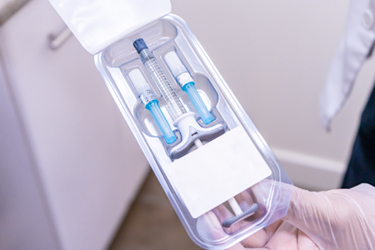Human Factors Engineering Considerations For Medical Device Packaging
By Sean Hägen, BlackHägen Design

Human factors engineering (HFE), also known as usability engineering (UE), comprises the knowledge of human behavior, abilities, limitations, and other characteristics of medical device users that are utilized in the design of medical devices. HFE involves mechanical and software-driven user interfaces (UI), systems, tasks, instructional documentation, packaging, labeling, and user training.
As an integral component of product design, HFE should be applied at the onset of a product-design initiative and carried out throughout the complete development process. Developing the foundation for how people interact with a proposed technology or device is a critical principle of HFE. Even though an early focus of HFE tends to be more product design-intense, it is also important to realize its impact on how that device should be packaged in a safe and efficient manner for not only all end users but also for regulatory authorities for validation.
Regulatory Considerations For Packaging And Labeling Compliance
Regulatory requirements from agencies like the FDA consider the packaging and labeling as a significant part of the user interface. Packaging and labeling go through a validation process, where safe and effective use must be demonstrated. This is why the usability of the packaging is a principal design consideration as well as why the proactive use of HFE principles ensures user acceptance and a successful validation.
The healthcare industry puts a lot of emphasis on getting packaging and labeling factored in early in the medical device’s product development process so that stress is alleviated, risk is minimized, and costly surprises are eliminated. Not only does it have a substantial influence on user satisfaction, it can also significantly impact user safety. The FDA isn’t concerned that a device manufacturer reaches its commercial objectives and marketing outcomes; rather, their concern is solely on risk management and eliminating any potential use errors that could result in harm during clinical care outcomes. The objective of HFE is to harmonize both use safety and ease of use. If evaluated early in the development process, the result is an optimal user experience and a positive clinical outcome for both the patient and the clinician.
In your quality assurance (QA) program, medical device manufacturers must also incorporate several elements that relate to labeling in order to meet the good manufacturing practice (GMP) requirements of quality system regulations. The QA program must be adequate to ensure that labeling meets the GMP device master record requirements with respect to legibility, adhesion, and placement, as well as to ensure that labeling operations are controlled so that the correct labeling is always issued and properly applied.
Usability Considerations
Often packaging and labeling are difficult to separate one from the other since labeling is often seen as part of the packaging and both are seen as medical device user interfaces. Typically, medical device packaging incorporates critical labeling information as part of the package, such as equipment labels, control labels, package labels, directions for use, maintenance manuals, etc. Additionally, the displays on CRTs and other electronic display panels are considered labeling if instructions, prompts, cautions, and parameter identification information are given.
Regarding the application of HFE, it is important to note that labeling is not the only impact on usability. There is the mechanical and industrial design of the packaging that can have tremendous impact on usability from both a risk management and ease of use perspective. For example, the packaging can bring about a positive experience for intended access by using an intuitive sequence that is aligned with a purposeful workflow. The packaging can also accentuate labeling of criticality through the physical arrangement of the device in the packaging and associated labeling. Additionally, labeling can direct users to remove surgical instruments from packaging in the purest way possible into the sterile field to minimize contamination. On the contrary, deficiencies in the packaging design can be a detriment, introducing potential use errors that may have a significant impact on risk management in relation to user safety.
There can be numerous scenarios that occur within the medical device space, which is why understanding and addressing how packaging can influence device preparation and deployment is so important. Medical device usage in a home care setting is growing exponentially due to such reasons as baby boomers aging, awareness and acceptance among the population of home medical devices, and a greater focus on improving treatment outcomes, to name a few. The home medical device market is expected to reach $57,102.9 million in 2028 and a compound annual growth rate (CAGR) of 7.0% from 2021 to 2028, according to Insight Partners. It makes sense that the medical device packaging market would follow suit with its $29.78 billion market size and CAGR of 6.4% from 2020 to 2028, according to Grandview Research. It’s clear that packaging is becoming a more integral part of the overall medical device designs because it is seen as helping to ensure the safe and successful execution of a care activity.
Usage scenarios regarding packaging requirements vary greatly across the continuum of care. For example, there is a significant difference between a patient managing and operating a medical device themselves versus a trained clinician in a very controlled clinical environment, like an operating room or an ICU. There is a movement to develop more innovative and advanced technology devices for both the in-home and clinical environments, which leads its packaging to be more instrumental in the enhancement of the user experience and helps to assure user experiences result in positive clinical outcomes.
Looking at the many aspects of the packaging design of medical devices, it is easy to see how HFE can help direct device packaging development processes beyond conducting usability after the design has been developed. For instance, when the HFE team analyzes the workflow for care delivery using task analysis, it is important to assess the user’s interaction with the packaging, including all its layers (primary and secondary packaging), which is one of the initial tasks in the analysis.
The Value Of Task Analysis
HFE task analysis often reveals design packaging opportunities where workflow efficiency is enhanced by designing functionality that does more than protect the device during shipping and storage. Medical device manufacturers use HFE task analysis to outline the device kit contents and its purpose as well as deliver safer passage for a device from its packaging to the sterile field. It prioritizes the device kit contents in the order of use. When it provides a staging area for device usage and deployment, it also can deliver HFE task analysis that enables better access to labeling, like a quick reference guide, in addition to more efficient storage, including better access to the stored packaging.
Depending on feature complexity and functionality, the task analysis typically will not increase the recurring production cost of the packaging. For example, adding features to a thermoformed tray to organize and stage the contents may add design and testing time, but if the overall dimensions of the tray have not changed, the packaging production cost stays the same.
Prioritizing HFE Early In The Design Process
Packaging design improves when deploying HFE principles early in the process. It delves deeper beyond usability evaluations during product development cycles and ultimately delivers a better user experience and ensures safe execution.
Prioritizing packaging and sterilization at the onset of the design process facilitates commercialization and can accelerate time to market. Previously, packaging design and development used to happen during the last few stages of a medical device development process. But now, using HFE early on when designing the packaging system and selecting the appropriate materials, stress is alleviated during the commercial launch. Getting the packaging design process started early will not only create a more effective product, it will reduce timeline risks and any surprise costs of the packaging materials.
As we move into the future, expect to see more packaging innovations, such as 2-D bar codes with unique numbering/serialization, UV identification code, hologram, or hidden text printed using security or magnetic ink to safeguard against product counterfeiting.
About The Author:
 Sean Hägen is founding principal and director of research & synthesis at BlackHägen Design. He has more than 30 years of research and product development experience in a variety of industries and has led design research and usability design and testing across 18 countries. Hägen is a contributing author to domestic and international standards for usability development as a member of the AAMI HE committee; he was a lead author for AAMI TIR 50, TIR 59 and ANSI/AAMI HE75. He was the IDSA Medical Section Chair for eight years and sat on the Board of Directors for two terms. He initiated the first annual IDSA Medical Design Conference and currently chairs the IDSA Patient Safety Initiative. He earned a B.S. in product design from The Ohio State University’s Industrial Design program, minoring in human factors engineering.
Sean Hägen is founding principal and director of research & synthesis at BlackHägen Design. He has more than 30 years of research and product development experience in a variety of industries and has led design research and usability design and testing across 18 countries. Hägen is a contributing author to domestic and international standards for usability development as a member of the AAMI HE committee; he was a lead author for AAMI TIR 50, TIR 59 and ANSI/AAMI HE75. He was the IDSA Medical Section Chair for eight years and sat on the Board of Directors for two terms. He initiated the first annual IDSA Medical Design Conference and currently chairs the IDSA Patient Safety Initiative. He earned a B.S. in product design from The Ohio State University’s Industrial Design program, minoring in human factors engineering.
